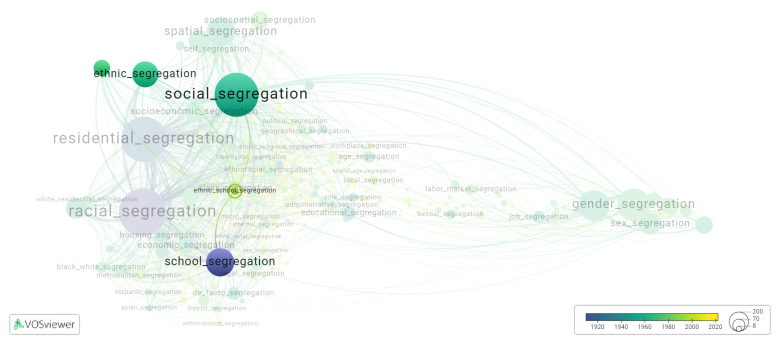Ethnic school segregation
Date and country of first publication[1][edit | edit source]
2007
Italy
Definition[edit | edit source]
Ethnic school segregation refers to the practice of separating students into schools based on their ethnicity or race. This form of segregation can be both de facto, occurring due to neighborhood demographics, or de jure, enforced by policies or laws.
Historically, ethnic school segregation has been prevalent in many societies, particularly during times of widespread discrimination and inequality. In the United States, for example, schools were often segregated based on race until the landmark Supreme Court case Brown v. Board of Education in 1954, which deemed racial segregation in public schools unconstitutional.
In some cases, ethnic school segregation continues to persist today, often due to the socio-economic factors that influence residential patterns and school enrollment. This can result in schools predominantly serving students from a particular ethnic or racial background, leading to unequal opportunities and disparities in educational quality.
Ethnic school segregation has been criticized for perpetuating inequality, promoting stereotypes, and limiting social integration and understanding. Many argue that diverse schools provide more inclusive learning environments that foster tolerance, empathy, and cultural exchange among students from different backgrounds.
Efforts to address ethnic school segregation include implementing policies to promote diversity and integration, such as using affirmative action measures in school admissions, creating magnet schools or specialized programs to attract a diverse student body, or redrawing school district boundaries to ensure diverse student populations.
However, achieving a fully integrated and diverse education system can be complex and faces challenges such as resistance from communities or logistical issues. Nonetheless, many believe that it is crucial to work towards eliminating ethnic school segregation to ensure equal access to quality education and foster a more inclusive society.
Synonyms[edit | edit source]
The following terms are synonymous with ethnic school segregation:
school ethnic segregation.
References and literature addressing this segregation form under these synonymous terms can be found below.
See also[edit | edit source]
Related segregation forms[edit | edit source]
Ethnic school segregation is frequently discussed in the literature with the following segregation forms:
school segregation, social segregation, ethnic segregation, school socioeconomic segregation, residential segregation, ethnic residential segregation

This visualization is based on the study The Multidisciplinary Landscape of Segregation Research.
For the complete network of interrelated segregation forms, please refer to:
References[edit | edit source]
Notes[edit | edit source]
- ↑ Date and country of first publication as informed by the Scopus database (December 2023).
At its current state, this definition has been generated by a Large Language Model (LLM) so far without review by an independent researcher or a member of the curating team of segregation experts that keep the Segregation Wiki online. While we strive for accuracy, we cannot guarantee its reliability, completeness and timeliness. Please use this content with caution and verify information as needed. Also, feel free to improve on the definition as you see fit, including the use of references and other informational resources. We value your input in enhancing the quality and accuracy of the definitions of segregation forms collectively offered in the Segregation Wiki ©.
Ethnic school segregation appears in the following literature[edit | edit source]
Dronkers J., Levels M. (2007). Do school segregation and school resources explain region of origin differences in the mathematics achievement of immigrant students?. Educational Research and Evaluation, 13(5), 435-462. https://doi.org/10.1080/13803610701743047
Kristen C. (2008). Primary school choice and ethnic school segregation in German elementary schools. European Sociological Review, 24(4), 495-510. https://doi.org/10.1093/esr/jcn015
Valiente O., Rambla X. (2009). The new Other Catalans at school: Decreasing unevenness but increasing isolation. International Studies in Sociology of Education, 19(2), 105-117. https://doi.org/10.1080/09620210903257190
Alegre M.À., Ferrer-Esteban G. (201). How do school regimes tackle ethnic segregation: Some insights supported in PISA 2006. Quality and Inequality of Education: Cross-National Perspectives, 137-162. Springer Netherlands.https://doi.org/10.1007/978-90-481-3993-4_6
Di Bartolomeo A. (2011). Explaining the gap in educational achievement between second generation immigrants and natives: The Italian case. Journal of Modern Italian Studies, 16(4), 437-449. https://doi.org/10.1080/1354571X.2011.593749
Hamnett C. (2012). Concentration or diffusion? the changing geography of ethnic minority pupils in English secondary schools, 1999 2009. Urban Studies, 49(8), 1741-1766. https://doi.org/10.1177/0042098011422573
Agirdag O., van Houtte M., van Avermaet P. (2012). Ethnic School Segregation and Self Esteem: The Role of Teacher Pupil Relationships. Urban Education, 47(6), 1135-1159. SAGE Publications Inc..https://doi.org/10.1177/0042085912452154
Makles A., Schneider K. (2015). Much ado about nothing? The role of primary school catchment areas for ethnic school segregation: Evidence from a policy reform. German Economic Review, 16(2), 203-225. Blackwell Publishing Ltd.https://doi.org/10.1111/geer.12048
Wicht A. (2016). Occupational aspirations and ethnic school segregation: social contagion effects among native German and immigrant youths. Journal of Ethnic and Migration Studies, 42(11), 1825-1845. Routledge.https://doi.org/10.1080/1369183X.2016.1149455
Teltemann J., Schunck R. (2016). Education systems, school segregation, and second generation immigrants’ educational success: Evidence from a country fixed effects approach using three waves of PISA. International Journal of Comparative Sociology, 57(6), 401-424. SAGE Publications Ltd.https://doi.org/10.1177/0020715216687348
Van der Bracht K., D’hondt F., Van Houtte M., Van de Putte B., Stevens P.A.J. (2016). The role of ethnic school segregation for adolescents’ religious salience. Oxford Review of Education, 42(2), 129-145. Routledge.https://doi.org/10.1080/03054985.2016.1151409
Plenty S., Jonsson J.O. (2017). Social Exclusion among Peers: The Role of Immigrant Status and Classroom Immigrant Density. Journal of Youth and Adolescence, 46(6), 1275-1288. Springer New York LLC.https://doi.org/10.1007/s10964-016-0564-5
Waldring I. (2017). Practices of change in the education sector: professionals dealing with ethnic school segregation. Ethnic and Racial Studies, 40(2), 247-263. Routledge.https://doi.org/10.1080/01419870.2017.1245434
Brandén M., Birkelund G.E., Szulkin R. (2019). Ethnic Composition of Schools and Students’ Educational Outcomes: Evidence from Sweden. International Migration Review, 53(2), 486-517. SAGE Publications Ltd.https://doi.org/10.1177/0197918318769314
Nielsen R.S., Andersen H.T. (2019). Ethnic school segregation in Copenhagen: A step in the right direction?. Urban Studies, 56(15), 3234-3250. SAGE Publications Ltd.https://doi.org/10.1177/0042098019847625
Lund S. (202). Immigrant Incorporation, Education, and the Boundaries of Belonging. Immigrant Incorporation, Education, and the Boundaries of Belonging, 1-131. Springer International Publishing.https://doi.org/10.1007/978-3-030-36729-9
Sage L., Flache A. (2021). Can ethnic tolerance curb self reinforcing school segregation? A theoretical agent based model. JASSS, 24(2), -. University of Surrey.https://doi.org/10.18564/jasss.4544
